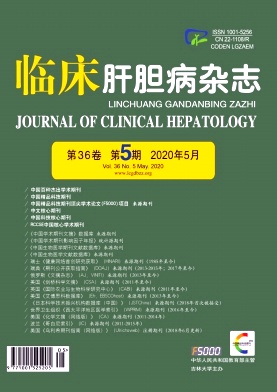|
[1] FATTOVICH G, GIUSTINA G, SCHALM SW, et al. Occurrence of hepatocellular carcinoma and decompensation in western European patients with cirrhosis type B. The EUROHEP Study Group on Hepatitis B virus and cirrhosis[J]. Hepatology, 1995, 21(1):77-82.
|
|
[2] PENG CY, CHIEN RN, LIAW YF. Hepatitis B virus-related decompensated liver cirrhosis:Benefits of antiviral therapy[J]. J Hepatol, 2012, 57(2):442-450.
|
|
[3] SINGAL AK, FONTANA RJ. Meta-analysis:Oral anti-viral agents in adults with decompensated hepatitis B virus cirrhosis[J]. Aliment Pharmacol Ther, 2012, 35(6):674-689.
|
|
[4] Chinese Society of Hepatology and Chinese Society of Infectious Diseases, Chinese Medical Association. The guideline of prevention and treatment for chronic hepatitis B:A 2015 update[J]. J Clin Hepatol, 2015, 31(12):1941-1960.(in Chinese)中华医学会肝病学分会,中华医学会感染病学分会.慢性乙型肝炎防治指南(2015年更新版)[J].临床肝胆病杂志,2015, 31(12):1941-1960.
|
|
[5] FATTOVICH G, BORTOLOTTI F, DONATO F. Natural history of chronic hepatitis B:Special emphasis on disease progression and prognostic factors[J]. J Hepatol, 2008, 48(2):335-352.
|
|
[6] JANG JW, CHOI JY, KIM YS, et al. Effects of virologic response to treatment on short-and long-term outcomes of patients with chronic hepatitis B virus infection and decompensated cirrhosis[J]. Clin Gastroenterol Hepatol, 2018, 16(12):1954-1963. e3.
|
|
[7] FONTANA RJ, HANN HW, PERRILLO RP, et al. Determinants of early mortality in patients with decompensated chronic hepatitis B treated with antiviral therapy[J]. Gastroenterology,2002, 123(3):719-727.
|
|
[8] CHEN CJ, YANG HI, SU J, et al. Risk of hepatocellular carcinoma across a biological gradient of serum hepatitis B virus DNA level[J]. JAMA, 2006, 295(1):65-73.
|
|
[9] JU YC, JUN DW, CHOI J, et al. Long term outcome of antiviral therapy in patients with hepatitis B associated decompensated cirrhosis[J]. World J Gastroenterol, 2018, 24(40):4606-4614.
|
|
[10] KIM TS, SINN DH, KANG W, et al. Hepatitis B virus DNA levels and overall survival in hepatitis B-related hepatocellular carcinoma patients with low-level viremia[J]. J Gastroenterol Hepatol, 2019, 34(11):2028-2035.
|
|
[11] PAPATHEODORIDIS GV, MANOLAKOPOULOS S, TOULOUMI G,et al. Virological suppression does not prevent the development of hepatocellular carcinoma in HBeAg-negative chronic hepatitis B patients with cirrhosis receiving oral antiviral(s)starting with lamivudine monotherapy:Results of the nationwide HEPNET.Greece cohort study[J]. Gut, 2011, 60(8):1109-1116.
|
|
[12] HOSAKA T, SUZUKI F, KOBAYASHI M, et al. Long-term entecavir treatment reduces hepatocellular carcinoma incidence in patients with hepatitis B virus infection[J]. Hepatology, 2013, 58(1):98-107.
|
|
[13] PAPATHEODORIDIS GV, MANOLAKOPOULOS S, TOULOUMI G, et al. Hepatocellular carcinoma risk in HBeAg-negative chronic hepatitis B patients with or without cirrhosis treated with entecavir:HepNet. Greece cohort[J]. J Viral Hepat, 2015,22(2):120-127.
|
|
[14] HOU JL, ZHAO W, LEE C, et al. Outcomes of long-term treatment of chronic HBV infection with entecavir or other agents from a randomized trial in 24 countries[J]. Clin Gastroenterol Hepatol, 2020, 18(2):457-467. e21.
|
|
[15] NAM JY, CHANG Y, CHO H, et al. Delayed viral suppression during antiviral therapy is associated with increased hepatocellular carcinoma rates in HBeAg-positive high viral load chronic hepatitis B[J]. J Viral Hepat, 2018, 25(5):552-560.
|













 DownLoad:
DownLoad: